Student-t Process#
PyMC3 also includes T-process priors. They are a generalization of a Gaussian process prior to the multivariate Student’s T distribution. The usage is identical to that of gp.Latent, except they require a degrees of freedom parameter when they are specified in the model. For more information, see chapter 9 of Rasmussen+Williams, and Shah et al..
Note that T processes aren’t additive in the same way as GPs, so addition of TP objects are not supported.
Samples from a TP prior#
The following code draws samples from a T process prior with 3 degrees of freedom and a Gaussian process, both with the same covariance matrix.
import matplotlib.pyplot as plt
import numpy as np
import pymc3 as pm
import theano.tensor as tt
%matplotlib inline
/anaconda3/lib/python3.6/site-packages/h5py/__init__.py:36: FutureWarning: Conversion of the second argument of issubdtype from `float` to `np.floating` is deprecated. In future, it will be treated as `np.float64 == np.dtype(float).type`.
from ._conv import register_converters as _register_converters
# set the seed
np.random.seed(1)
n = 100 # The number of data points
X = np.linspace(0, 10, n)[:, None] # The inputs to the GP, they must be arranged as a column vector
# Define the true covariance function and its parameters
ℓ_true = 1.0
η_true = 3.0
cov_func = η_true**2 * pm.gp.cov.Matern52(1, ℓ_true)
# A mean function that is zero everywhere
mean_func = pm.gp.mean.Zero()
# The latent function values are one sample from a multivariate normal
# Note that we have to call `eval()` because PyMC3 built on top of Theano
tp_samples = pm.MvStudentT.dist(mu=mean_func(X).eval(), cov=cov_func(X).eval(), nu=3).random(size=8)
## Plot samples from TP prior
fig = plt.figure(figsize=(12, 5))
ax = fig.gca()
ax.plot(X.flatten(), tp_samples.T, lw=3, alpha=0.6)
ax.set_xlabel("X")
ax.set_ylabel("y")
ax.set_title("Samples from TP with DoF=3")
gp_samples = pm.MvNormal.dist(mu=mean_func(X).eval(), cov=cov_func(X).eval()).random(size=8)
fig = plt.figure(figsize=(12, 5))
ax = fig.gca()
ax.plot(X.flatten(), gp_samples.T, lw=3, alpha=0.6)
ax.set_xlabel("X")
ax.set_ylabel("y")
ax.set_title("Samples from GP");
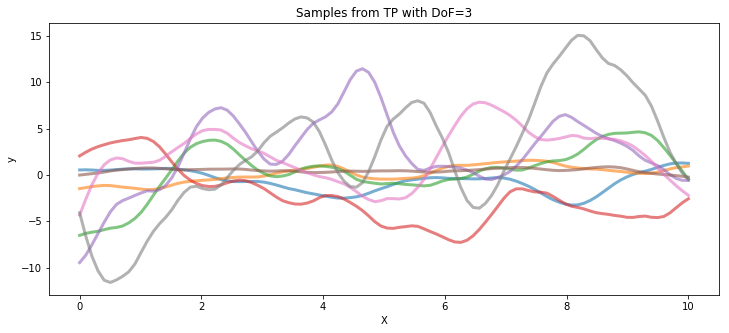
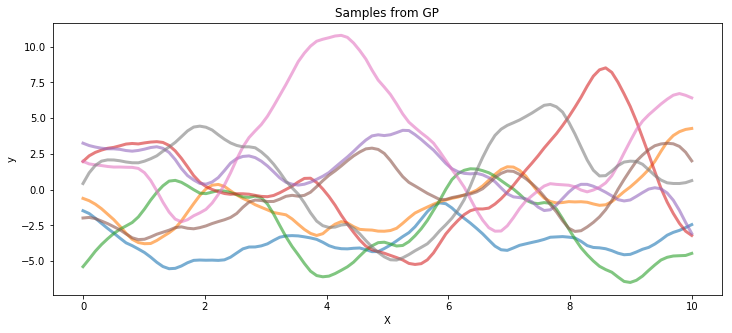
Poisson data generated by a T process#
For the Poisson rate, we take the square of the function represented by the T process prior.
np.random.seed(7)
n = 150 # The number of data points
X = np.linspace(0, 10, n)[:, None] # The inputs to the GP, they must be arranged as a column vector
# Define the true covariance function and its parameters
ℓ_true = 1.0
η_true = 3.0
cov_func = η_true**2 * pm.gp.cov.ExpQuad(1, ℓ_true)
# A mean function that is zero everywhere
mean_func = pm.gp.mean.Zero()
# The latent function values are one sample from a multivariate normal
# Note that we have to call `eval()` because PyMC3 built on top of Theano
f_true = pm.MvStudentT.dist(mu=mean_func(X).eval(), cov=cov_func(X).eval(), nu=3).random(size=1)
y = np.random.poisson(f_true**2)
fig = plt.figure(figsize=(12, 5))
ax = fig.gca()
ax.plot(X, f_true**2, "dodgerblue", lw=3, label="True f")
ax.plot(X, y, "ok", ms=3, label="Data")
ax.set_xlabel("X")
ax.set_ylabel("y")
plt.legend();
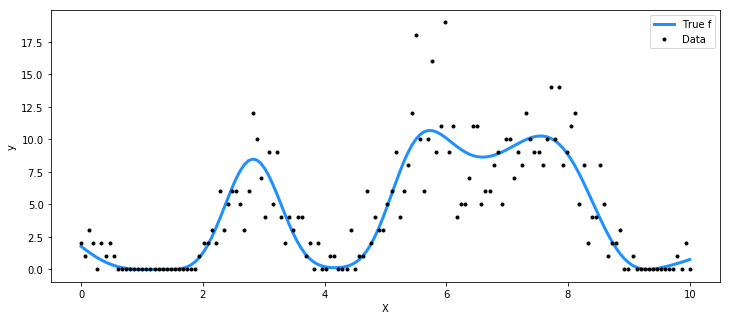
with pm.Model() as model:
ℓ = pm.Gamma("ℓ", alpha=2, beta=2)
η = pm.HalfCauchy("η", beta=3)
cov = η**2 * pm.gp.cov.ExpQuad(1, ℓ)
# informative prior on degrees of freedom < 5
ν = pm.Gamma("ν", alpha=2, beta=1)
tp = pm.gp.TP(cov_func=cov, nu=ν)
f = tp.prior("f", X=X)
# adding a small constant seems to help with numerical stability here
y_ = pm.Poisson("y", mu=tt.square(f) + 1e-6, observed=y)
tr = pm.sample(1000)
Auto-assigning NUTS sampler...
Initializing NUTS using jitter+adapt_diag...
Multiprocess sampling (2 chains in 2 jobs)
NUTS: [f_rotated_, chi2_, ν, η, ℓ]
Sampling 2 chains: 100%|██████████| 3000/3000 [39:12<00:00, 1.02s/draws]
There were 11 divergences after tuning. Increase `target_accept` or reparameterize.
There were 4 divergences after tuning. Increase `target_accept` or reparameterize.
The gelman-rubin statistic is larger than 1.4 for some parameters. The sampler did not converge.
The estimated number of effective samples is smaller than 200 for some parameters.
pm.traceplot(tr, var_names=["ℓ", "ν", "η"]);
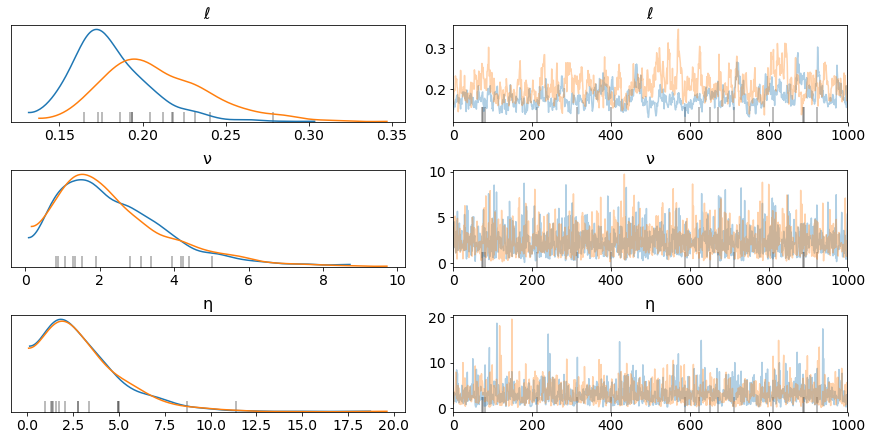
n_new = 200
X_new = np.linspace(0, 15, n_new)[:, None]
# add the GP conditional to the model, given the new X values
with model:
f_pred = tp.conditional("f_pred", X_new)
# Sample from the GP conditional distribution
with model:
pred_samples = pm.sample_posterior_predictive(tr, vars=[f_pred], samples=1000)
100%|██████████| 1000/1000 [00:46<00:00, 22.68it/s]
fig = plt.figure(figsize=(12, 5))
ax = fig.gca()
from pymc3.gp.util import plot_gp_dist
plot_gp_dist(ax, np.square(pred_samples["f_pred"]), X_new)
plt.plot(X, np.square(f_true), "dodgerblue", lw=3, label="True f")
plt.plot(X, y, "ok", ms=3, alpha=0.5, label="Observed data")
plt.xlabel("X")
plt.ylabel("True f(x)")
plt.ylim([-2, 20])
plt.title("Conditional distribution of f_*, given f")
plt.legend();
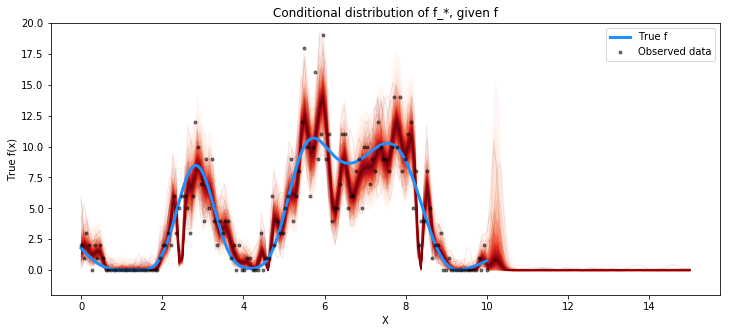
%load_ext watermark
%watermark -n -u -v -iv -w
pymc3 3.8
arviz 0.8.3
numpy 1.17.5
last updated: Thu Jun 11 2020
CPython 3.8.2
IPython 7.11.0
watermark 2.0.2